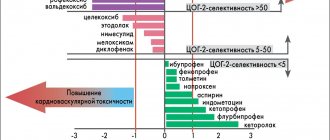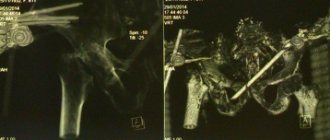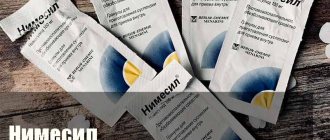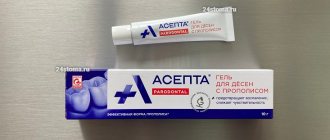Kamistad: composition and release form
Kamistad is a modern drug for the treatment of dental diseases. This drug effectively reduces pain and inflammation in the mouth and lips. The German company produces the drug in children's and adult forms, 10 g each in an aluminum tube. Kamistad gel has an anti-inflammatory and strong analgesic effect due to the content of the following components:
1. Kamistad for adults 2% (content per 100 g of gel):
- lidocaine (monohydrate) – 2 g;
- chamomile flower extract – 18.5 g.
Auxiliary components: 200 mg of 50% benzalkonium chloride solution, 100 mg of camphor cinnamon oil, 100 mg of sodium saccharinate, 1.5 g of carbomer, 40 mg of 98% formic acid, 2.81 g of trometamol, 820 mg of 96% ethanol, 73.93 g distilled water.
2. Kamistad for children:
- polidocanol;
- extract from chamomile flowers.
Auxiliary components: carbomer, glycerol, water, propylene glycol and other components. The excipients also include flavors (mint and honey), they give the gel a pleasant smell and taste, which children especially like.
What is prohibited?
- To prevent accidental washing of a blood clot from the socket, it is forbidden to rinse your mouth. To treat the cavity, oral baths are quite sufficient;
- Hot compresses are prohibited, this stimulates severe swelling, the development of inflammation, and bleeding;
- You cannot puff out your cheeks, blow your nose too much, or sneeze;
- It is forbidden to touch the wound with your fingers, tongue, or objects;
- You can’t eat hot, cold, irritating foods; preference is for soft, warm, neutral foods;
- you cannot smoke or drink alcohol for at least a week - tobacco and alcohol slow down tissue regeneration;
- Hypothermia and overheating must be avoided - going to the sauna, swimming pool, solarium is prohibited for 5-7 days;
- Do not take aspirin or other blood thinners;
- do not engage in active sports, do not subject the body to excessive physical or sports stress.
Why is this composition so good?
The gel quickly relieves pain and effectively relieves inflammation due to the content of antiseptics and anesthetics in the composition. Chamomile extract acts as an antiseptic, which has an anti-inflammatory and healing effect. Anesthetics (lidocaine and polidocanol) relieve itching, cool, soothe the mucous membrane, and also block pain impulses from the first seconds of applying the gel.
Purpose of Kamistad gel
Dentists recommend using Kamistad for diseases such as:
- stomatitis of any etiology;
- gingivitis;
- cheilitis (inflammation of the lips);
- erythema of the lips.
Dental gel can also be used in the following cases:
- in case of injury to the oral mucosa (from the use of dentures, after operations);
- with irritation from wearing braces;
- during teething
;
- during orthodontic and dental procedures.
Kamistad gel is an immediate local anesthesia; the drug effectively eliminates inflammation, regenerating the tissue of the lips and oral mucosa.
What can and should be done after tooth extraction
- 20-30 minutes after the intervention, carefully remove the cotton swab
; - use cold compresses
for 2-3 hours after the intervention (take a break every 10-15 minutes to avoid tissue hypothermia); - for 3-5 days, make oral baths
with antiseptic solutions (take the solution, hold it in your mouth for a minute, spit); - When carrying out daily hygiene, avoid the injured area
, you can start using the toothbrush on the 2-3rd day, it should be new, with soft bristles; - chew on the opposite side
; - Eating is allowed after the anesthesia wears off (not earlier than 3-4 hours later
).
Contraindications of the drug
As experts note, Kamistad gel is very well tolerated by patients, however, due to the specific composition, the product is not recommended for use in the following cases:
- with arterial hypertension;
- with heart failure;
- with bradycardia (slow heartbeat);
- with renal failure;
- during lactation and pregnancy;
- with liver failure;
- if the child's age is less than 3 months.
It is also not recommended to use the gel in patients who have hypersensitivity to lidocaine, chamomile or auxiliary components of the drug.
special instructions
What do dentists recommend to their patients when they prescribe Kamistad?
Before use, you should always wash your hands thoroughly to avoid introducing infection into the oral cavity. Under no circumstances should the gel get into your eyes.
Benzalkonium chloride (antiseptic), which is part of the gel, can cause the formation of black pigment plaque on tooth enamel. Chromatogenic staining of enamel is a temporary and non-hazardous defect, but it does not go away on its own and must be removed in the dental office with professional teeth cleaning.
.
Kamistad: instructions for use
Kamistad is very easy to use, but before use it is necessary to carry out preparatory procedures: wash your hands thoroughly, dry the mucous membranes of the mouth and lips with a dry gauze swab.
To relieve pain, 1 drop of dental gel is enough. The gel is applied to the finger and gently rubbed into the problem area.
Children are allowed to use Kamistad Baby no more than 3 times a day; adults use Kamistad as needed, but no more than 6 times a day.
In the process of adaptation to dentures, the product is applied to the diseased area, and then the denture
installs immediately. If ulcers appear in your mouth, you should urgently contact a dental clinic for advice.
The drug contains benzalkonium chloride; for this reason, the gel is not allowed to be used for stomatitis with erosions and ulcers in the mouth. It also makes sense to use a dental drug only as part of a complex treatment; Kamistad itself cannot cope with aphthous or herpetic stomatitis, since it does not have the necessary anti-inflammatory and antiviral properties.
What absolutely should not be done if you have a toothache?
- Heat the sore spot, because heat intensifies the inflammatory process and discomfort increases several times. When the ternary nerve is inflamed, heat is needed. The patient cannot diagnose this disease on his own.
- You should not lie down to rest on the sore side. But if the pain strikes late at night, you should take a painkiller and lie down on the healthy side.
- Chew food while affecting the aching tooth. This can lead to increased inflammation and a general worsening of the situation.
- Don't brush your teeth. Insufficient oral hygiene leads to the proliferation of bacteria and increased inflammation.
- Keep the tooth cold. Dentists recommend that patients avoid drafts and walks in windy or frosty weather.
"Do no harm!" – this is the main principle of independent struggle with pain. It is worth adhering to in order to filter the advice of well-wishers for the presence of common sense in them.
IMPORTANT: all of the above tips on how to get rid of toothache are temporary solutions. You can resort to them only under one condition, if we are talking about a subsequent visit to the dentist and complex treatment.
Try not to let the situation get worse and not to self-medicate, so as not to harm your health and not waste valuable time treating a complicated disease. The dentists of the Nurimed clinic will help you get rid of pain and restore the health of your teeth. To make an appointment at a convenient time in St. Petersburg, just call and you will be scheduled for a consultation, at which the clinic’s dentist will choose an effective treatment.
Features of use during lactation and pregnancy
According to the original instructions, contraindications include lactation and pregnancy. However, this is not a strict contraindication; in practice, the dentist can recommend the drug to patients if absolutely necessary. However, during such an important period, it is better for women to give preference to alternative drugs such as Cholisal or Metrogyl Denta.
"Cholisal" relieves inflammation, pain and kills pathogenic microorganisms. According to the original instructions, it can be used by women both during pregnancy and lactation, but with caution, not exceeding the dose of the drug.
"Metrogid Dent" is only suitable for relieving inflammation; the drug cannot boast of an analgesic effect like Kamistad. This dental gel is only allowed to be used by pregnant women during the 2nd and 3rd trimesters. During lactation, the drug should not be used either; the active components easily pass into breast milk, but if necessary, breastfeeding can be stopped.
Mechanism of pain
- Trauma to soft, hard periodontal tissues;
- damage (rupture) of the connective tissue holding the tooth;
- destruction of blood vessels and nerve endings;
- swelling of the injured gum, pressure on nearby areas, poor circulation;
- irradiation of pain along the nerve trunks to other parts of the maxillofacial areas.
Pain after extraction of any dental unit is a natural reaction of the body to the intervention. No matter how carefully the surgeon acts, the integrity of the vessels, nerves, and fibers is inevitably compromised. It is normal for the extracted tooth to hurt for no more than 2-3 days.
, after removing the figure eight, the gums may bother you
for about a week
. If after 7-10 days the discomfort does not disappear, but continues or increases, you need the help of a doctor.
Kamistad: reviews from specialists and patients
Dentists speak very positively about Kamistad and call it an emergency solution for toothache. Patients who used this product reported effectiveness and rapid action. You don't have to wait long, just a few seconds after application and the pain goes away. Some patients suffering from stomatitis used the gel a few minutes before meals - this reduced pain during meals and provided comfort.
For children who are teething, this drug is very necessary; the gel not only reduces pain, but also relieves irritation, inflammation and calms the child.
Causes of toothache
Unpleasant sensations can occur in children and adults. They can be associated with dental diseases or caused by other reasons. Let's take a closer look at the causes of toothache.
Why does it hurt?
- Pulpitis is an acute inflammatory process in the pulp.
- Complications after installation of a filling.
- Gingivitis is an inflammatory process in the gums.
- Complications after tooth extraction.
- Periodontitis is the appearance of throbbing pain that intensifies when touched.
- Periodontitis is an inflammation of the tissue at the root, which causes a cyst.
- Thin tooth enamel, cracks on the surface.
A tooth may hurt due to a blood disease, problems with the nervous or vascular system. The true cause is determined by the doctor during the examination. To relieve discomfort before a consultation, a person can look at home or in a pharmacy for something that helps with toothache. Painkillers allow you to sleep at night or finish important tasks and then visit the dentist.
What benefits do dentists and patients report?
- Versatility of use.
The drug is available in two forms, which allows it to be used by both children and adults.
- In
normal doses, the drug is inert and does not react with other drugs
, which makes it possible to include it in combination therapy. - No side effects or overdose
, if you use the drug according to the instructions. Otherwise, redness, burning and itching may occur at the application site, and in severe cases, swelling of the oral mucosa may occur.
- The gel contains sugar.
- The gel form of the product allows the active components to penetrate quickly and deeply into the tissues
, providing a strong and long-lasting analgesic effect.
- Kamistad gel does not affect the psychomotor state of the patient
, so it can be used while driving vehicles or working with complex mechanisms.
- Children enjoy the taste and smell of Kamistad Baby
.
- The gel is applied topically
, the effect is instant.
- Availability and popularity.
Kamistad is sold without a prescription, so you can easily purchase it at any pharmacy.
- There is no need to store the product in the refrigerator
, besides, after opening the tube, Kamistad is suitable for up to 1 year.
Reasonable choice of NSAIDs for combined pathologies: joint diseases and hypertension
Nonsteroidal anti-inflammatory drugs (NSAIDs) are one of the main groups of drugs used in the treatment of rheumatoid arthritis (RA). The anti-inflammatory and analgesic effect of this group of drugs is associated with the suppression of the activity of cyclooxygenase-2 (COX-2) at the site of inflammation - the key enzyme in the synthesis of prostaglandins of pro-inflammatory activity, and the suppression of the COX-1 isoform leads to disruption of physiological reactions: in particular, to disruption of the synthesis of prostaglandins of the class E in the gastric mucosa and the development of NSAID gastropathy.
Most “standard” NSAIDs are able to suppress the activity of both COX isoforms, so their use is often limited due to the development of side effects, primarily from the gastrointestinal tract (GIT). Subjective symptoms from the gastrointestinal tract occur in approximately a third of patients, and in 5% of cases they pose a serious threat to the lives of patients. That is why in recent years the problem of the safe use of NSAIDs has attracted particular attention. It is believed that drugs that are more selective for COX-2 are less likely to cause the development of NSAID gastropathy. The study of the mechanisms of action of NSAIDs gave impetus to the creation of new drugs that have all the positive properties of standard NSAIDs, but are less toxic—specific COX-2 inhibitors [3, 4, 13].
In recent years, the problem of interaction between NSAIDs and antihypertensive drugs, as well as the connection between the use of NSAIDs and the development of hypertension, has become particularly relevant. Non-selective NSAIDs can lead to an increase in blood pressure (mainly diastolic) not only in patients with arterial hypertension (AH), but also in people with normal blood pressure due to inhibition of systemic and local, intrarenal prostaglandin synthesis. It is known that chronic use of NSAIDs causes an increase in blood pressure in patients by an average of 5.0 mmHg. Art. A characteristic property of NSAIDs is also their interaction with antihypertensive drugs, the hypotensive action of which is based primarily on prostaglandin-dependent mechanisms. Prescribing NSAIDs to patients receiving beta-blockers, ACE inhibitors and diuretics for hypertension leads to a decrease in the hypotensive effect [8, 9].
Nimesulide was developed back in 1985 and is one of the first NSAIDs, the study of which demonstrated higher selectivity for COX-2 and accumulated extensive clinical experience. Numerous in vitro and in vivo studies have shown that nimesulide is approximately 5 to 20 times more selective in inhibiting COX-2 than COX-1. Of great interest is the fact that nimesulide has a wide range of COX-independent effects, which can determine its anti-inflammatory, analgesic and chondroprotective activity [1, 2, 5, 7, 11, 12].
Nimesulide is well tolerated by patients and rarely causes serious side effects requiring discontinuation of the drug. According to the results of a number of studies, the frequency of side effects that develop while taking nimesulide is not significantly different from placebo or is lower than when taking other NSAIDs. For example, according to a meta-analysis, in patients receiving nimesulide, the overall incidence of gastrointestinal adverse reactions was significantly lower (8.7%) than when prescribing other NSAIDs (16.8%). The low incidence of gastrointestinal lesions during treatment with nimesulide is associated not only with the COX-2 selectivity of the drug, but also with the antihistamine effect, leading to a decrease in the secretion of hydrochloric acid in the stomach [6, 10, 13].
Thus, nimesulide is a selective COX-2 inhibitor, comparable in effectiveness to “classical” NSAIDs, but has a more favorable toxicity profile. Pharmacoeconomic analysis indicates the advantages of nimesulide compared to diclofenac, primarily due to the lower incidence of gastrointestinal lesions.
The purpose of our study was to study the effectiveness and tolerability of Nise (nimesulide) in patients with RA in comparison with ortofen (diclofenac).
Materials and methods
Both NSAIDs were randomly assigned to 40 patients from the time of first diagnosis of RA, according to the criteria of the American College of Rheumatology. Nise was used in the form of tablets of 100 mg twice a day, ortofen - in the form of tablets of 25 mg in a daily dose of 150 mg. At the same time, all patients received basic therapy, mainly methotrexate or sulfasalazine. The efficacy and tolerability of NSAIDs were assessed after 3 weeks. from the start of treatment, i.e. in those periods when the effect of basic drugs did not yet have clinical significance.
In group I of 20 patients receiving Nise, there were 14 women and 6 men, the average age of the patients was 55.1 years, the duration of the articular syndrome at the time of diagnosis was from 3 to 14 months, on average 7.25 months. In group II of 20 patients receiving ortofen, there were 18 women and 2 men, the average age of the patients was 42.75 years, the duration of the articular syndrome was from 2 to 14 months, on average 5.65 months. Clinical characteristics of both groups are presented in Table 1.
The treatment results were assessed by the dynamics of joint syndrome indicators (Ritchey joint index (RI), painful joint score (PJS), swollen joint score (SJS), duration of morning stiffness (min), severity of pain on a visual analogue scale (VAS)) and on based on an overall assessment of the effectiveness of treatment, in the opinion of the doctor and the patient. In addition, the dynamics of blood pressure during treatment with NSAIDs was assessed in all patients.
results
In group I, during treatment with Nise at a daily dose of 200 mg for 3 weeks. treatment, reliable dynamics of articular syndrome indicators was achieved. At the same time, the effectiveness of therapy was assessed by 17 patients (85%) as good and 3 (15%) as satisfactory. According to the doctor, in 16 cases (80%) good effectiveness of the drug was observed, in 4 cases (20%) it was satisfactory (Fig. 1). Tolerability of Nise was good in 85%, only 2 patients (10%) had heartburn and gastralgia, and 1 patient (5%) had a feeling of heaviness in the epigastric region. However, fibrogastroscopy did not reveal erosive damage to the gastric mucosa in these patients. In the group of patients taking Nise, not a single patient required discontinuation of the drug.
| Drawing. Assessing the effectiveness of drugs based on the opinions of the patient and the doctor |
In group II, during therapy with ortofen at a daily dose of 150 mg every 3 weeks. Significant dynamics of articular syndrome indicators were also noted. However, an assessment of the effectiveness of therapy showed that only 11 patients (55%) rated the effectiveness of the drug as good, 6 (30%) as satisfactory, and three patients (15%) considered it unsatisfactory. According to the attending physician, sufficient effectiveness of ortofen, corresponding to the “good” gradation, was noted in 12 cases (60%), satisfactory - in 3 (15%) and unsatisfactory - in 5 (25%) cases (Fig.).
Tolerability of the drug Ortofen was worse than that of Nise: 9 patients (45%) had symptomatic side effects, and 3 patients (15%) required discontinuation of the drug after 2 weeks. from the start of treatment due to erosive lesions of the mucous membrane of the antrum identified during FGDS. In general, the most common side effects were heartburn - in 7 (35%) patients, gastralgia - in 8 (40%), nausea - in 4 (20%) and diarrhea - in 2 (10%) patients.
Of particular interest is the effect of the studied NSAIDs on blood pressure levels, since out of 40 patients, 15 had concomitant hypertension, for which antihypertensive therapy was carried out. The dynamics of blood pressure levels in both groups during treatment with Nise and Ortofen are presented in Table 2. It should be noted that Nise therapy did not require an increase in ongoing antihypertensive therapy (β-blockers, ACE inhibitors, diuretics) and did not cause an increase in blood pressure in previously normotensive patients. At the same time, treatment with ortofen required dose adjustment of antihypertensive drugs in 4 (66.7%) of 6 patients with hypertension and caused an increase in blood pressure in 5 (25%) postmenopausal women with initially highly normal blood pressure. This effect of a non-selective NSAID - ortofen - should be considered predictable, especially taking into account the nature of the antihypertensive therapy being carried out. All hypertensive patients received β-blockers, ACE inhibitors and diuretics in various combinations; however, not a single patient was prescribed the dihydropyridine Ca antagonist amlodipine, which is the drug of choice for the treatment of hypertension in the setting of NSAID therapy.
Thus, the results of an open clinical trial showed that the drug Nise in patients with RA exhibits pronounced anti-inflammatory activity, superior to diclofenac. At the same time, Nise is characterized by good tolerability, a small number of symptomatic side effects and, from this point of view, is superior to the most widely used in clinical practice, ortofen. An additional advantage of the drug Nise can be considered a less pronounced effect on blood pressure levels. When prescribing Nise, no increase in the dose of antihypertensive drugs was required. Given the high prevalence of essential hypertension in the population, the interaction of NSAIDs with the most commonly used antihypertensive drugs seems to be an urgent problem. Rheumatic diseases that require constant NSAID therapy are often combined with hypertension. Moreover, in the majority of patients with hypertension, blood pressure correction can be achieved only through combination antihypertensive therapy, and monotherapy with dihydropyridine calcium antagonists is considered insufficiently effective. Consequently, in most cases, when treating inflammatory rheumatic diseases in people suffering from hypertension, it is impossible to completely neutralize the negative interaction of “standard” NSAIDs with the main cardiac drugs - beta-blockers, ACE inhibitors and diuretics. In such a situation, it seems a rational choice for anti-inflammatory therapy with specific COX-2 inhibitors, of which Nise is a representative.
Literature
- Balabanova R. M. Nimesulide is an anti-inflammatory drug with selective inhibition of COX-2. - RMJ, 2001. - 9. - pp. 291-292.
- Nasonov E. L. Prospects for the use of the new non-steroidal anti-inflammatory drug nimesulide. - Wedge. Pharmacol. and therapy, 1999. - 8. - P. 65–69.
- Nasonov E. L. The use of non-steroidal anti-inflammatory drugs and cyclooxygenase-2 inhibitors at the beginning of the 21st century. - RMJ, 2003. - T. 11. - No. 7.
- Nasonov E. L. Specific inhibitors of COX-2: solved and unresolved problems. - Wedge. Pharmacol. and therapy, 2000. - 1. - P. 57–64.
- Nasonov E. L. Efficacy and tolerability of the non-steroidal anti-inflammatory drug Nimesulide: new data. - RMJ, 2001. - 9. - P. 636-639.
- Bennet A., Villa G. Nimesulid: an NSAID that preferentially inhibits COX-2, and has various unique pharmacological activities. Exp. Opin. Pharmacotherapy, 2000, 1, 277-286.
- Bernareggi A. Clinical pharmacokinetics of nimesulide. Clinical Pharmacokinet., 1998, 35, 247-274.
- Gurwitz JH, Avorn J, Bohn RL et al. Initiation of antihypertensive treatment during nonsteroidal anti-inflammatory drug therapy. JAMA, 1994, 272, 781-786.
- Jonson AG, Nguyen TV, Day RO Do nonsteroidal anti-inflammatory drugs affect blood pressure? A meta analysis. Ann. Intern. Med., 1994, 121, 289-300.
- Rabasseda X. Safety profile of nimesulide: ten years of clinical experience. Drugs of Today, 1997, 33, (Suppl.1), 1-11.
- Rainsford KD Nimesulid: overview of properties and application. Drugs of Today, 2001, 37(Suppl.B), 3-7.
- Singla AK, Chawla M., Singh A. Nimesulid: some pharmaceutical and pharmacological aspects - an update. J. Pharmac. Pharmacol., 2000, 52, 467-486.
- Wolfe F, Anderson J, Burke TA, Arguelles LM, Pettitt D. Gastroprotective therapy and risk of gastrointestinal ulcers: risk reduction by COX 2 therapy. J. Rheumatol., 2002, 29, 467-473.
I. M. Marusenko , Candidate of Medical Sciences N. N. Vezikova , Candidate of Medical Sciences, Associate Professor V. K. Ignatiev , Doctor of Medical Sciences, Professor Petrozavodsk University, Department of Hospital Therapy
Gel Kamistad: analogues and prices
Gel Kamistad - the price is about 250 rubles (data as of March 2017), there are no direct analogues at a lower price.
Analogues of Kamistad in terms of therapeutic effect:
- Holisal.
- Luan.
- Dantol, Dentol baby.
- Kalgel.
- Lidocaine.
- Lidoxor.
- Dentagel.
- Solcoseryl and others.
Comparison with other drugs
The properties of the drug “Kalgel” are very similar to Kamistad; it also contains lidocaine and a chemical antiseptic. The only difference between the Kalgel gel is that its anesthetic effect is weaker and can only be used by children from 5 months. However, “Kalgel” can be used even for ulcerative stomatitis; it also provokes less salivation, which is very good if it is necessary to numb the teeth of a one-year-old baby.
Cholisal gel has a wider spectrum of action than Kamistad, it relieves pain, relieves inflammation, and destroys pathogenic microorganisms. However, the anise oil included in the composition provokes strong salivation, so it is not recommended for use in infancy.
The article was written by a dentist with 12 years of experience!
Stages of socket healing
- 2-3 hours
after
a blood clot (thrombus) forms
in the socket . It serves as a barrier to pathogenic microorganisms, preventing them from entering the wound. - The next 2-3 days
- the blood clot thickens, shrinks, the wound
becomes covered with a whitish coating
(fibrin film), the formation of granulation tissue begins inside the hole, the basis for the restoration of mucous membranes. - After 3-7 days
, the thrombus lightens, becomes whitish, the connective tissue has practically filled the hole, swelling and pain are minimal or completely absent. - After 7-10 days
, the hole has shrunk significantly,
new bone begins to form
, which will completely fill the defect after 4-6 months. - After 2 weeks
,
the gums have completely healed
.









